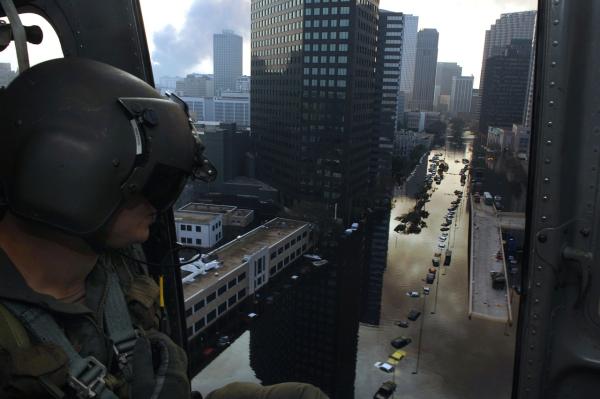The end of summer invites disasters: hurricanes and high temperatures, floods and wildfires. Disasters cry for mass insurance relief, states of emergency, and urgent rescue missions. Resources, including human energy, are limited, and not everyone can be rescued. Some will have natural deaths, others perhaps unnatural. How do we deal with those who can’t be rescued? The legal, emergency, social, and political systems don’t have answers, and planning for these expected crises is wanting. The Anna Pou case is telling and chilling.
Katrina and Memorial Hospital
By August 30, 2005, shortly after Katrina made landfall, Memorial Hospital in New Orleans was flooded with ten feet of water. By early September, the emergency generators failed, the elevators stopped working, and food was running out. Medical equipment, some life-saving, like ventilators, failed. Then, the water and sewage system crashed. Nurses used their hands to manually breathe for patients on ventilators till exhaustion overwhelmed them. Temperatures hovered at 100 degrees.
Rescue efforts were limited to removing patients by a 3x3 foot opening in a machine room to a helipad or carrying patients to rescue boats down as many as seven flights of (unlighted) stairs. The patients were prioritized for rescue according to a triage procedure. Patients who did not want to be resuscitated (DNRs) were classified as Group 3, the last to leave.
Then there were the 52 patients on the seventh and eighth floors, residents in LifeCare, a long-term facility for elderly patients with multiple medical problems [1] many in critical condition, some obese enough to make transport virtually impossible) weren’t included in the initial triage/rescue plans. In discussing evacuation, this group wasn’t addressed because everyone thought rescue efforts would suffice and it wouldn’t be needed.
Slowly, patients and staff were evacuated. But eventually, coast guard crews and helicopters stopped rescue efforts at Memorial in favor of other venues. Finally, only a handful of medical personnel remained. The sole physician remaining, Dr. Anna Pou, was left “holding the bag.” Of morphine, that is.
After three days of the living hell (when over a hundred patients were carried to rescue, with others dying of insufficient oxygen), Dr. Pou, apparently after consultation with other doctors, administered morphine and midazolam, ostensibly to relieve the anxiety of the remaining patients knowing they would be spending at least another day in what can only be said was a replica of Dante’s Inferno. Some said her motives were more nefarious.
Finally, after four days, the hospital was empty- except for 45 corpses. No other New Orleans hospital had as many. But then again, allegations claim that other hospitals were prioritized for rescue. [(2) Nine of the Memorial cases on the Life Alert floors were found to have morphine in their systems.
“The pathologist found that all four patients died by way of homicide as a result of human intervention.” - NY Times
The attorney general’s office hired a forensic pathologist to review the toxicology reports of four of these nine patients. Dr. Pou was charged with manslaughter in the four cases and conspiracy to commit manslaughter in all nine.
The fine line
No federal law applies to Dr. Pou’s situation. The Emergency Medical Treatment and Labor Act (EMTALA) only addresses emergency visits, and the persons attended to by Dr. Pou were already admitted. The Volunteer Protection Act of 1997 provides immunities to volunteers, but Dr. Pou was not considered a volunteer (although I wonder at what point during an emergency when all other staff members evacuate, but some “volunteer” to stay on; we can say this law protects them).
Louisiana’s Good Samaritan laws, which remove liability for civil damages, similarly are inapplicable because they don’t apply to on-duty staff physicians. Again, when physicians work around the clock, can they be said to be on duty for four days 24/7?
A model state law, the Health Emergency Powers Act adopted by Louisiana in 2003, should have provided immunity. It didn’t. That law states:
“[D]uring a state of public health emergency, any health care providers shall not be civilly liable for causing the death of, or injury to, any person…except in the event of gross negligence or willful misconduct.”
These provisions did not stop Dr. Pou from being arrested and charged. The grand jury, however, refused to indict her, and she was left facing three civil lawsuits, subsequently settled. Is it fair when Dr. Pou put herself in jeopardy to care for as many patients as possible while other physicians evacuated?
Where is the line?
“I’d rather be considered a person who abandoned patients than someone who aided in eliminating patients”
- Dr. Bryant King, a physician at Memorial
“Several … forensic experts, including Cyril Wecht, … and Michael Baden, reviewed the reports on the nine suspicious LifeCare facility deaths. Wecht believed that eight of the nine were homicides. Baden thought all nine were homicides…..."
"When you use both [morphine and Versed] together, it becomes a lethal cocktail that guarantees they're gonna die. This is not euthanasia. This is plain and simple homicide."
- Louisiana Attorney General at a press conference following the arrests.
However, other experts claimed that determining the cause of death in bodies sitting for ten days in 100-degree temperatures was impossible. One expert advised that the cause of death in each case should remain undetermined.
“It was actually to the point where you were considering that you couldn’t just leave them; the humane thing would be to put ‘em out.”
– Dr. Ewing Cook, a Memorial pulmonologist.
But “[Cook] found that achieving this level of comfort required enough morphine that the drug markedly suppressed the patient’s breathing. The intent was to provide comfort, but the result was to hasten death, and Cook knew it. To Cook, the difference between something ethical and something illegal ‘‘is so fine as to be imperceivable.’’
Morphine is used to a patient’s benefit- to relieve pain and save lives. It can also kill depending on dose and intent. The actual intent of Dr. Pou, whether to ease anxiety, to calm patients, or to compassionately address the inevitable end of life, will never be known. Whatever the answer, she suffered in making the decision, calling the subsequent arrest a "personal tragedy.”
“The distinction between murder and medical care often comes down to the intent of the person administering the drug.”
- The Deadly Choices at Memorial Propublica
Dr. Pou has her proponents and detractors. But other physicians also were said to administer morphine- as the humane thing to do. The law did not pursue them.
Some claim that had the patients been kept alive, they would have eventually been rescued. Others allege that the physical state of these patients (350 pounds or more) made evacuation impossible or that the physiological condition (requiring ventilation) was sure to result in death, making rescue dangerous to the rescuers.
The “true” answer to the intent of Dr. Pou (to alleviate anxiety or to humanely prevent a horrible and sentient death) will never be known. The decision was based on an individual’s view of what was best for the patient. What does matter is how we handle this type of situation in the future.
[1] Many were in critical condition, and some obese enough to make transport virtually impossible.
[2] Private Bodies, Public Texts: Race, Gender, and a Cultural Bioethics by Karla FC Holloway
[3] “Gross negligence” has been defined as the “want of even slight care and diligence” and the “want of that diligence which even careless men are accustomed to exercise.” “Willful misconduct” generally refers to conduct undertaken by one who knows she is committing or intends wrongdoing.
Sources: The Case of Dr. Anna Pou: Physician Liability in Emergency Situations Health Law
Five Days at Memorial – History versus Hollywood
The Deadly Choices at Memorial NY Times Magazine
Five Days at Memorial by Sherri Fink




